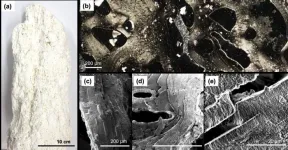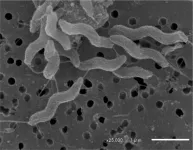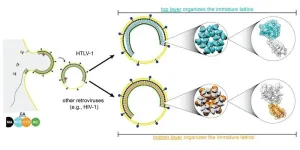(Press-News.org) Researchers led by Ryuhei Nakamura at the RIKEN Center for Sustainable Resource Science (CSRS) in Japan and The Earth-Life Science Institute (ELSI) of Tokyo Institute of Technology have discovered inorganic nanostructures surrounding deep-ocean hydrothermal vents that are strikingly similar to molecules that make life as we know it possible. These nanostructures are self-organized and act as selective ion channels, which create energy that can be harnessed in the form of electricity. Published Sep. 25 in Nature Communications, the findings impact not only our understanding of how life began, but can also be applied to industrial blue-energy harvesting.
When seawater seeps way down into the Earth through cracks in the ocean floor, it gets heated by magma, rises back up to the surface, and is released back into the ocean through fissures called hydrothermal vents. The rising hot water contains dissolved minerals gained from its time deep in the Earth, and when it meets the cool ocean water, chemical reactions force the mineral ions out of the water where they form solid structures around the vent called precipitates.
Hydrothermal vents are thought to be the birthplace of life on Earth because they provide the necessary conditions: they are stable, rich in minerals, and contain sources of energy. Much of life on Earth relies on osmotic energy, which is created by ion gradients—the difference in salt and proton concentration—between the inside and outside of living cells. The RIKEN CSRS researchers were studying serpentinite-hosted hydrothermal vents because this kind of vent has mineral precipitates with a very complex layered structure formed from metal oxides, hydroxides, and carbonates. “Unexpectedly, we discovered that osmotic energy conversion, a vital function in modern plant, animal, and microbial life , can occur abiotically in a geological environment,” says Nakamura.
The researchers were studying samples collected from the Shinkai Seep Field, located in the Pacific Ocean’s Mariana Trench at a depth of 5743 m. The key sample was an 84-cm piece composed mostly of brucite. Optical microscopes and scans with micrometer-sized X-ray beams revealed that brucite crystals were arranged in continuous columns that acted as nano-channels for the vent fluid. The researchers noticed that the surface of the precipitate was electrically charged, and that the size and direction of the charge—positive or negative—varied across the surface. Knowing that structured nanopores with variable charge are the hallmarks of osmotic energy conversion, they next tested whether osmotic energy conversion was indeed occurring naturally in the inorganic deep-sea rock.
The team used an electrode to record the current-voltage of the samples. When the samples were exposed to high concentrations of potassium chloride, the conductance was proportional to the salt concentration at the surface of the nanopores. But at lower concentrations, the conductance was constant, not proportional, and was determined by the local electrical charge of the precipitate’s surface. This charge-governed ion transport is very similar to voltage-gated ion channels observed in living cells like neurons.
By testing the samples with chemical gradients that exist in the deep ocean from where they were extracted, the researchers were able to show that the nanopores act as selective ion channels. At locations with carbonate adhered to the surface, the nanopores allowed positive sodium ions to flow through. However, at nanopores with calcium adhered to the surface, the pores only allowed negative chloride ions to pass through.
“The spontaneous formation of ion channels discovered in deep-sea hydrothermal vents has direct implications for the origin of life on Earth and beyond,” says Nakamura. “In particular, our study shows how osmotic energy conversion, a vital function in modern life, can occur abiotically in a geological environment.”
Industrial power plants use salinity gradients between seawater and river water to generate energy, a process called blue-energy harvesting. According to Nakamura, understanding how nanopore structure is spontaneously generated in the hydrothermal vents could help engineers devise better synthetic methods for generating electrical energy from osmotic conversion.
END
Nanostructures in the deep ocean floor hint at life’s origin
2024-09-25
ELSE PRESS RELEASES FROM THIS DATE:
Humbug damselfish use 'motion dazzle' to evade predators
2024-09-25
When thinking of animal camouflage, we typically imagine creatures remaining still, blending seamlessly into their surroundings. But remaining motionless isn’t always practical, and many animals are highly mobile, constantly moving through their environment to graze their food.
New research suggests that high-contrast patterns on animals’ bodies may serve a dual purpose: offering camouflage when stationary, then creating a ‘motion dazzle’ effect when moving, confusing potential predators into misjudging their location – and helping them avoid being ...
Can a drug-free nasal spray protect against deadly respiratory infections?
2024-09-25
New research published in Advanced Materials reports a novel nasal spray for preventing respiratory infections. The spray works by forming a protective coating on the nasal cavity, which captures airborne respiratory droplets and acts as a physical barrier against viruses and bacteria, while effectively neutralizing them.
In studies conducted on mice, the Pathogen Capture and Neutralizing Spray (PCANS) demonstrated up to 8 hours of nasal retention. In a severe Influenza A model, a single pre-exposure dose of PCANS resulted in a greater than 99.99% reduction ...
Do natural disasters jeopardize women’s reproductive health?
2024-09-25
In research published in Brain and Behavior, investigators found increased rates of menstrual irregularities in women living in areas affected by the 2023 earthquake in Turkey.
In the study, 309 women of reproductive age living in regions declared as disaster areas completed online forms 9 months after the earthquake. Responses revealed an increase of menstrual irregularities from 14.3% before the earthquake to 44.8% after the earthquake. Risk factors for menstrual irregularities included post-traumatic stress symptoms, chronic diseases, and smoking.
The findings reveal that reproductive health ...
Can cosmic radiation in outer space affect astronauts’ long-term cognition?
2024-09-25
During missions into outer space, galactic cosmic radiation (GCR) will penetrate current spacecraft shielding and thus pose a significant risk to human health. Previous studies have shown that GCR can cause short-term cognitive deficits in male rodents. Now a study published in the Journal of Neurochemistry reveals that GCR exposure can also cause long-lasting learning deficits in female rodents.
The impact of GCR on cognition was lessened when mice were fed an antioxidant and anti-inflammatory compound called CDDO-EA.
Beyond ...
Do preventive health technologies promote or harm consumers’ wellbeing?
2024-09-25
Preventive health technologies—such as wrist-worn activity trackers or health and fitness apps—are popular tools for promoting wellbeing, but new research published in the Journal of Consumer Affairs reveals that consumer engagement with these technologies can be considered a double-edged sword.
The study, which involved 30 in-depth interviews with users, found that consumers engage with preventive health technologies based on a variety of health goals—for example, to lose weight, improve performance, monitor data of an enjoyable activity, or acquire a healthy routine.
These diverse goals led users ...
Preclinical studies suggest a drug-free nasal spray could ward off respiratory infections
2024-09-25
Researchers from the Brigham detail how the spray they created may offer broad-spectrum protection from respiratory infections by COVID-19, influenza, everyday cold viruses, and pneumonia-causing bacteria
A new study details how a nasal spray formulated by investigators from Brigham and Women’s Hospital, a founding member of the Mass General Brigham healthcare system, may work to protect against viral and bacterial respiratory infections. Based on their preclinical studies, the researchers say the broad-spectrum nasal spray is long-lasting, safe, and, if validated in humans, could play a key role in reducing respiratory diseases ...
Campylobacter jejuni-specific antibody gives hope to vaccine development
2024-09-25
Bacterial infections resulting in enteritis, sometimes extra-intestinal infections such as sepsis, continue to be a global health concern. A leading cause of diarrheal and extra-intestinal infectious mortality among children under 5 and elderly persons is infection with Campylobacter bacteria, against which there is no effective vaccine or medication. An Osaka Metropolitan University-led team has recently uncovered what could be an important step toward preventing, diagnosing, and treating a species of Campylobacter bacteria.
Researchers including Professor Shinji Yamasaki and Associate Professor Noritoshi Hatanaka of the Graduate School ...
A viral close-up of HTLV-1
2024-09-25
Martin Obr is on edge, anxiously waiting for his train to the airport. A storm called “Sabine” is brewing, shutting down all public transport. He catches his flight from Frankfurt to Vienna just in time.
Obr spent the last days in Germany meticulously analyzing what he calls the “perfect sample”. This sample helped him and Florian Schur from the Institute of Science and Technology Austria (ISTA) decode the structure of a virus called HTLV-1 (Human T-cell Leukemia Virus Type 1).
In collaboration with the University of Minnesota and Cornell University, ...
Virtual reality can help pedestrians and cyclists swerve harmful pollutants – study
2024-09-25
Physics-informed virtual reality could be key to reducing the exposure of pedestrians and cyclists to harmful, non-exhaust vehicle emissions, according to a study published today (25 Sep) in the Royal Society Open Science journal.
The research lead by the University of Birmingham (supported by Rosetrees Trust and Research England QR Funding), targets the issue of major health risks and chronic diseases caused by exposure to unregulated particle pollutants from road, tyre and brake sources by providing easy, accessible guidance to the public, policy makers, and city planners, through immersive VR experiences.
Detailed ...
Neuroscience luminary Hermona Soreq sheds light on the roles of RNA regulators in neurodegenerative diseases
2024-09-25
In a compelling Genomic Press Interview published in Brain Medicine on September 25, 2024, Professor Hermona Soreq of the Hebrew University of Jerusalem in Israel unveils the profound implications of her groundbreaking research on the cholinergic system and small RNA regulators in brain-body communication.
Prof. Soreq, holder of the Endowed Slesinger Professorship of Molecular Neuroscience, has dedicated her career to unraveling the complexities of the parasympathetic nervous system, with a particular focus on acetylcholine's role in stress responses and neurodegenerative diseases. Her work has revolutionized our understanding of how the brain ...





